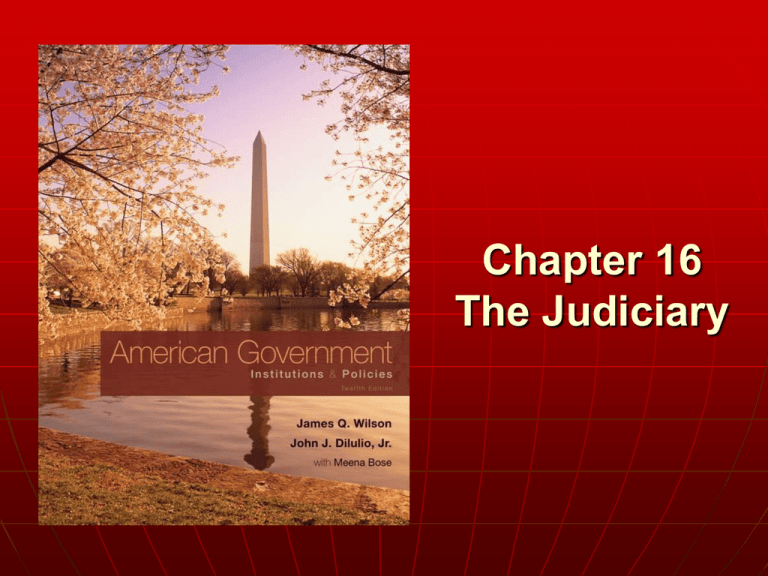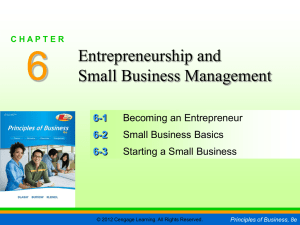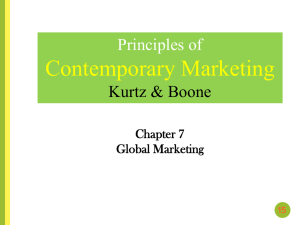Chapter 16 - Augusta County Public Schools
advertisement

Chapter 16 The Judiciary WHO GOVERNS? 1. Why should federal judges serve for life? TO WHAT ENDS? 1. Why should federal courts be able to declare laws unconstitutional? 2. Should federal judges only interpret existing laws or should they be able to create new laws? Copyright © 2011 Cengage Overview Judicial Review – the power of courts to declare laws unconstitutional Judicial Restraint Approach – judges should decide cases strictly on the basis of the language of the Constitution Activist Approach – judges should discern the general principles underlying the Constitution and apply them to modern circumstances Copyright © 2011 Cengage Copyright © 2011 Cengage The Development of the Federal Courts National Supremacy and Slavery • Marbury v Madison (1803) • McCulloch v Maryland (1819) • Dred Scot decision (1857) Government and the Economy Government and Political Liberty The Revival of State Sovereignty Copyright © 2011 Cengage Library of Congress/LC-USZ62-44166 Roger B. Taney, chief justice from 1836 to 1864, wrote the Dred Scott decision, which asserted that blacks were not citizens of the United States. Dred Scott claimed that when his master brought him north to a free state, he ceased to be a slave. The public outcry against the decision was intense, at least in the North, as is evident from this poster announcing a mass meeting “to consider the atrocious decision.” p. 434 Copyright © 2011 Cengage Copyright © 2011 Cengage Bettmann/Corbis The “nine old men”—The Supreme Court in 1937, not long after President Franklin D. Roosevelt tried, unsuccessfully, to “pack” it by appointing six additional justices who would have supported his New Deal legislation. Justice Owen J. Roberts (standing, second from the left) changed his vote on these matters, and the Court ceased to be a barrier to the delegation of power to the bureaucracy. P. 435 Copyright © 2011 Cengage Map 16.1 U.S. District and Appellate Courts Note: Washington, D.C., is in a separate court. Puerto Rico is in the first circuit; the Virgin Islands are in the third; Guam and the Northern Mariana Islands are in the ninth. Source: Administrative Office of the United States Courts (January 1983). Copyright © 2011 Cengage The Structure of the Federal Courts Lower Federal Courts • Constitutional Court District courts Courts of appeal • Legislative Court Court of Military Appeals Selecting Judges • Senatorial Courtesy • The “Litmus Test” Copyright © 2011 Cengage Figure 16.1 Female and Minority Judicial Appointments, 1963–2004 Source: Updated from Harold W. Stanley and Richard G. Niemi, Vital Statistics on American Politics, 2005– 2006 (Washington, D.C.: Congressional Quarterly, 2006), table 7.5. Copyright © 2011 Cengage Figure 16.1 Female and Minority Judicial Appointments, 1963–2004 Source: Updated from Harold W. Stanley and Richard G. Niemi, Vital Statistics on American Politics, 2005– 2006 (Washington, D.C.: Congressional Quarterly, 2006), table 7.5. Copyright © 2011 Cengage Figure 16.2 Confirmation Rates for Nominees to the U.S. Court of Appeals (1947–2005) Source: “The Consequences of Polarization: Congress and the Courts” by Sarah A. Binder, in David Brady and Pietro Nivola, Eds., Red and Blue Nation? (Vol. 2) Consequences and Correction of America’s Polarized Politics. Brookings Institutions and Hoover Institution Presses. Reprinted with permission of the author. Copyright © 2011 Cengage Karen Bleier/AFP/Getty Images Sonia Sotomayor became the third female and first Hispanic justice on the Supreme Court. p. 440 Copyright © 2011 Cengage The Jurisdiction of the Federal Courts Federal-question cases – Cases concerning the Constitution, federal laws, or treaties Diversity cases – Cases involving citizens of different states who can bring suit in federal courts Writ of certiorari – An order by a higher court directing a lower court to send up a case for review. Copyright © 2011 Cengage Figure 16.3 The Jurisdiction of the Federal Courts p. 441 Copyright © 2011 Cengage Getting to Court In forma pauperis Fee Shifting Standing Class Action Suits Carl Iwasaki/Time Life Pictures/Getty Images Linda Brown was refused admission to a white elementary school in Topeka, Kansas. On her behalf, the NAACP brought a class-action suit that resulted in the 1954 landmark Supreme Court decision Brown v. Board of Education. p. 445 Copyright © 2011 Cengage Copyright © 2011 Cengage The Supreme Court in Action Brief Amicus curiae Per curiam opinion Opinion of the court Concurring opinion Dissenting opinion Copyright © 2011 Cengage Charles Dharapak/AP Photo The members of the Supreme Court, front row, from left are: Anthony Kennedy, John Paul Stevens, Chief Justice John Roberts, Antonin Scalia, and Clarence Thomas. Back row, from left are: Samuel Alito, Ruth Bader Ginsburg, Stephen Breyer, and Sonia Sotomayor. P. 447 Copyright © 2011 Cengage The Power of the Federal Courts The Power to Make Policy • Stare decisis • Political question • Remedy Views of Judicial Activism Legislation and the Courts Copyright © 2011 Cengage Alex Webb/Magnum Photos The activism of federal courts is exemplified by the sweeping orders they have issued to correct such problems as overcrowded prisons. p. 448 Checks on Judicial Power • Confirmations • Impeachment • Number of judges • Jurisdiction Bettmann/Corbis Thurgood Marshall became the first black Supreme Court justice. As chief counsel for the NAACP, Marshall argued the 1954 Brown v Board of Education case in front of the Supreme Court. He was appointed to the Court in 1967 and served until 1991. p. 452 Congress and the Courts Public Opinion and the Courts Copyright © 2011 Cengage Figure 16.4 Public Confidence in the Court, 1974 - 2006 Source: The Gallup Poll. Copyright © 2011 Cengage WHAT WOULD YOU DO? MEMORANDUM To: Senator Ann Gilbert From: Amy Wilson, legislative assistant The Supreme Court has held that the attorney general cannot use his authority over federally controlled drugs to block the implementation of the Oregon “Death With Dignity” law. Now some of your colleagues want to enact a federal equivalent of that law that would allow physicians to prescribe deadly drugs to patients who request them. Copyright © 2011 Cengage WHAT WOULD YOU DO? Arguments for: 1. The law respects the people’s rights to choose the time and place of their own death. 2. It is already permissible to post “Do Not Resuscitate” orders on the charts of terminally ill patients. 3. Physicians can be held to high standards in implementing the law. Copyright © 2011 Cengage WHAT WOULD YOU DO? Arguments against: 1. The law will corrupt the role of doctors as many think has happened in Holland, where a similar law has led some physicians to kill patients prematurely or without justification. 2. Such a law will lead some physicians to neglect or ignore the desires of the patient. 3. This law will undermine the more important goal of helping patients overcome pain and depression. Copyright © 2011 Cengage WHAT WOULD YOU DO? Your decision: Support the law? Oppose the law? Copyright © 2011 Cengage







